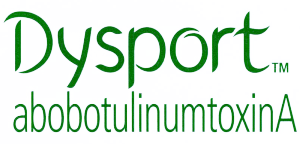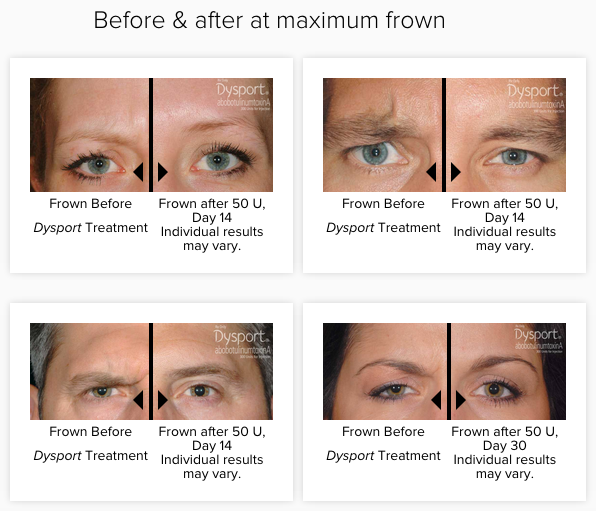Dysport™
Dysport™

How do you know if Dysport™ works?
Clinically proven results with 1 treatment
In 3 clinical studies of people whose frown lines were rated “moderate” or “severe” by a doctor before their treatment with Dysport™:
- 30 days after treatment, the majority (88 percent, 85 percent and 86 percent in each of the 3 studies) had their frown lines rated by a doctor as “mild” or “moderate” at maximum frown. For example, a patient could improve from “severe” to “moderate” or from “moderate” to “mild.”
- 30 days after treatment, the majority (74 percent, 79 percent and 82 percent in each of the 3 studies) rated their own frown lines as “mild” or “moderate” at maximum frown. For example, a patient could improve from “severe” to “moderate” or from “moderate” to “mild.”
Used worldwide
Dysport™ is used for aesthetic purposes in 36 countries. In the United States, Dysport™ was studied for safety in more than 2,400 U.S. patients, and today more than 200,000 women and men have been treated with Dysport™.
Unretouched images of patients at maximum frown

Individual results may vary
Three double-blind, randomized, placebo-controlled, clinical studies evaluated the efficacy of Dysport™ for use in the temporary improvement of the appearance of moderate to severe glabellar lines, These 3 studies enrolled healthy adults (ages 19-75) with glabellar lines of at least moderate severity at maximum frown. Subjects were excluded if they had marked ptosis, deep dermal scarring, or a substantial inability to lessen glabellar lines, even by physically spreading them apart. The subjects in these studies received either Dysport™ or a placebo. The total dose was delivered in equally divided aliquots to specified injection sites.

How do you know if Dysport™ works?
Clinically proven results with 1 treatment
In 3 clinical studies of people whose frown lines were rated “moderate” or “severe” by a doctor before their treatment with Dysport™:
- 30 days after treatment, the majority (88 percent, 85 percent and 86 percent in each of the 3 studies) had their frown lines rated by a doctor as “mild” or “moderate” at maximum frown. For example, a patient could improve from “severe” to “moderate” or from “moderate” to “mild.”
- 30 days after treatment, the majority (74 percent, 79 percent and 82 percent in each of the 3 studies) rated their own frown lines as “mild” or “moderate” at maximum frown. For example, a patient could improve from “severe” to “moderate” or from “moderate” to “mild.”
Used worldwide
Dysport™ is used for aesthetic purposes in 36 countries. In the United States, Dysport™ was studied for safety in more than 2,400 U.S. patients, and today more than 200,000 women and men have been treated with Dysport™.
Unretouched images of patients at maximum frown

Individual results may vary
Three double-blind, randomized, placebo-controlled, clinical studies evaluated the efficacy of Dysport™ for use in the temporary improvement of the appearance of moderate to severe glabellar lines, These 3 studies enrolled healthy adults (ages 19-75) with glabellar lines of at least moderate severity at maximum frown. Subjects were excluded if they had marked ptosis, deep dermal scarring, or a substantial inability to lessen glabellar lines, even by physically spreading them apart. The subjects in these studies received either Dysport™ or a placebo. The total dose was delivered in equally divided aliquots to specified injection sites.

How do you know if Dysport™ works?
Clinically proven results with 1 treatment
In 3 clinical studies of people whose frown lines were rated “moderate” or “severe” by a doctor before their treatment with Dysport™:
- 30 days after treatment, the majority (88 percent, 85 percent and 86 percent in each of the 3 studies) had their frown lines rated by a doctor as “mild” or “moderate” at maximum frown. For example, a patient could improve from “severe” to “moderate” or from “moderate” to “mild.”
- 30 days after treatment, the majority (74 percent, 79 percent and 82 percent in each of the 3 studies) rated their own frown lines as “mild” or “moderate” at maximum frown. For example, a patient could improve from “severe” to “moderate” or from “moderate” to “mild.”
Used worldwide
Dysport™ is used for aesthetic purposes in 36 countries. In the United States, Dysport™ was studied for safety in more than 2,400 U.S. patients, and today more than 200,000 women and men have been treated with Dysport™.
Unretouched images of patients at maximum frown

Individual results may vary
Three double-blind, randomized, placebo-controlled, clinical studies evaluated the efficacy of Dysport™ for use in the temporary improvement of the appearance of moderate to severe glabellar lines, These 3 studies enrolled healthy adults (ages 19-75) with glabellar lines of at least moderate severity at maximum frown. Subjects were excluded if they had marked ptosis, deep dermal scarring, or a substantial inability to lessen glabellar lines, even by physically spreading them apart. The subjects in these studies received either Dysport™ or a placebo. The total dose was delivered in equally divided aliquots to specified injection sites.


